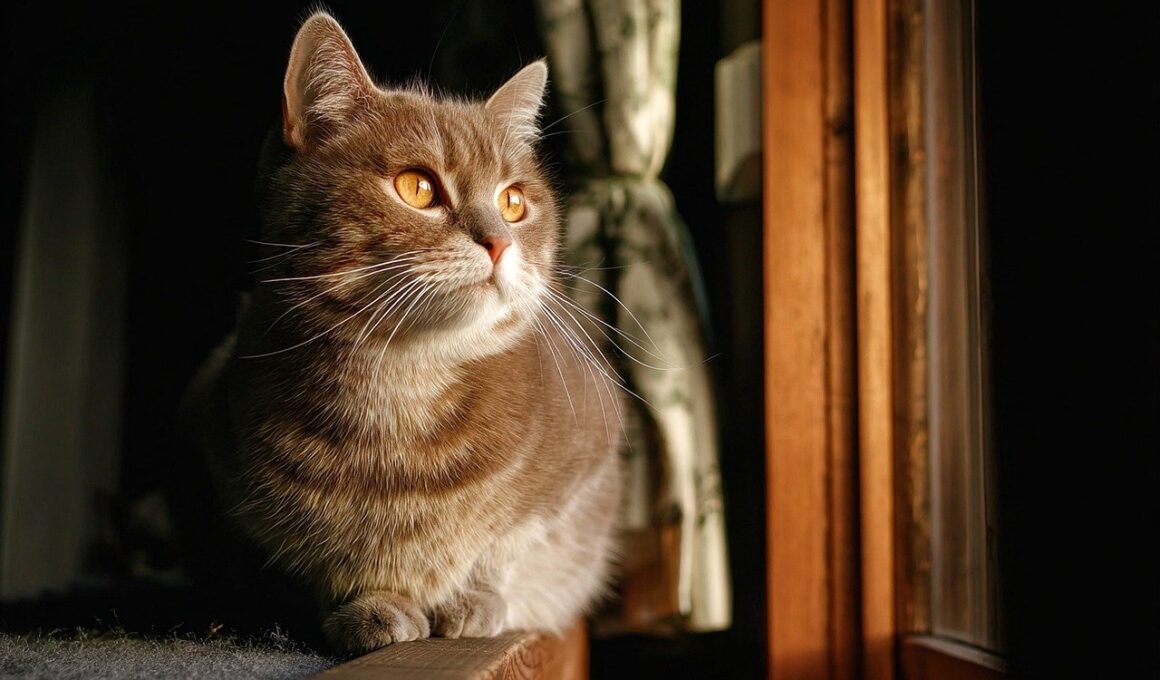Creating Quiet Retreats for Breeding Cats in Multicat Situations
In multicat situations, it’s essential to create quiet retreats for breeding cats to maintain their well-being and comfort. Breeding environments can become chaotic, especially with the presence of multiple cats vying for attention and territory. Providing designated quiet spaces can help mitigate stress and support the breeding cycle effectively. These retreats should be calm, cozy, and away from the daily hustle and bustle. Using soft bedding and cushions can provide physical comfort. Additionally, incorporating calming elements such as pheromone diffusers and soft lighting will create a soothing environment. Cats are naturally territorial, so creating spaces that feel safe and secure helps reduce anxiety. These quiet areas should have plenty of vertical space that allows cats to climb and observe their surroundings. It’s also vital to ensure that fresh water and food are accessible, as this encourages well-being and helps maintain nutritional needs. Quiet retreats serve as hiding spots, ensuring that breeding cats can retreat and experience less social stress. This additional comfort significantly impacts the overall health and happiness of your breeding cats. A well-planned retreat maximizes their potential for successful breeding while preserving their mental health.
To further enhance the quiet retreats, consider integrating enrichment items that allow for appropriate stimulation without overwhelming them. Choose items that promote exploration and play at their own pace. For example, providing scratching posts, soft toys, or interactive feeders can keep breeding cats engaged without the sensory overload often associated with more active spaces. It’s also important to provide an assortment of hiding spots, like cat caves or enclosed shelves, where cats can feel secure. These spaces allow them to observe their environment from a safe distance. Environmental enrichment will not only help alleviate boredom but also promote natural behaviors, which is crucial during the breeding process. Taking the time to create an engaging and quiet area offers a balance of activity and serenity. Incorporating elements that cater to their playful nature while maintaining the peaceful atmosphere proves beneficial for their physical and emotional health. Rotation of toys will keep the environment fresh and engaging, fostering curiosity. The key focus is on providing a serene retreat where breeding cats can feel safe, comfortable and stress-free, thus enhancing their overall reproductive success.
The Role of Space in Breeding Cat Retreats
Space management plays an integral role in establishing quiet retreats for breeding cats in multicat environments. Ensuring adequate physical space allows for privacy and reduces the potential for conflict among cats. Designing retreats that incorporate adequate distance from communal areas is critical for creating a soothing atmosphere. The ideal setup includes separate rooms or corners that are not directly adjacent to high-traffic areas. An effective strategy is to use barriers or room dividers that provide visual separation while allowing airflow and smells to circulate. Understanding the dynamics of your specific feline group is essential when determining the number of retreats required. Each breeding cat should have its own designated area, minimizing stress and competition. Positioning these retreats strategically, along with suitable amenities, becomes imperative in fostering an ideal breeding environment. Moreover, ensuring that cats can escape and retreat when feeling overwhelmed significantly contributes to their comfort and calmness. Overall, thoughtful consideration of space not only promotes a properly enriched environment but also supports the natural instincts of cats. Effective space management can lead to happier, healthier breeding cats.
When designing quiet retreats, it’s crucial to keep safety in mind. Providing secure enclosures that prevent escape while allowing for ventilation will ensure breeding cats feel protected yet comfortable. Doors should be easy to open but securely closed to prevent unwanted interactions. Utilizing non-toxic materials for all retreat components will safeguard their well-being. Additionally, avoid items with small parts that could become choking hazards. Regularly checking the safety of the environment is paramount, as even minor disturbances can contribute to elevated stress levels. Always ensure that there are no sharp edges or hazardous substances nearby. It’s advisable to keep these areas clutter-free, presenting a calming ambiance that reduces the likelihood of accidents. A clean environment also promotes good hygiene, which is essential during the breeding process to maintain health. Routine cleaning of the space and all provided accessories will reduce environmental stressors. Furthermore, each retreat should be monitored for any signs of wear and tear. By prioritizing safety and cleanliness, you create a space worthy of providing a sanctuary for breeding cats that promotes both their physical health and emotional stability.
Maintaining Serenity in Multicat Environments
In multicat environments, serene retreats allow breeding cats to thrive. Noise reduction creates an atmosphere conducive to tranquility. Selecting specific locations that minimize noise, such as quieter corners of the home or designated rooms, will help substantially. Using soundproof materials like carpets or acoustic panels in these retreats can diminish disruptive sounds. Additionally, consider using calming music or white noise machines to moderate external sounds that may disturb the cats. Providing visual barriers can also help minimize perceived threats from other cats. Curtains or screens can create privacy, which can enhance a sense of safety during breeding. Furthermore, maintaining a low-stress environment is vital. Regularly rotating the cats in and out of these retreats can help avoid overcrowding and allow each cat personal time. Equally important is the human interaction; spending dedicated, calm moments with the breeding cats fosters bonds and decreases anxiety. These principles should guide the care of breeding cats, ensuring a harmonious coexistence among cats while promoting their overall well-being. In addition to enhancing tranquility, these practices lay the groundwork for successful breeding outcomes, leading to healthy litters.
To conclude, creating quiet retreats for breeding cats in multicat situations is a multifaceted task encompassing physical space, safety, comfort, and enrichment. The retreat’s design should focus on reducing stress, which directly contributes to healthier breeding processes. By trying to maintain a tranquil atmosphere, yet enriching each area with engaging items, you can find the right balance between stimulation and relaxation. Providing sufficient space allows cats the freedom to choose when to engage or retreat, promoting their natural instincts. Regularly monitoring the environment will help maintain a safe haven for the cats, ensuring their needs are met. Additionally, incorporating calming elements and reducing noise will positively impact the behavior of breeding cats. These retreats are not merely about physical accommodations; they offer emotional support essential for successful breeding. Careful planning ensures a functional retreat that enhances the well-being of each cat while meeting their natural behavioral needs. Ultimately, the quiet retreat concept benefits the breeding process by focusing on creating optimal conditions for cats to thrive. Such solutions foster not only healthy breeding practices but also enrich the overall lives of your cats.
Implementation Tips for Cat Breeders
In implementing retreats for breeding cats, careful planning is key. Begin by assessing the space available and identifying potential areas for enhancement. Create a checklist of features that each retreat should contain, such as bedding, feeding areas, and enrichment items. Consider using modular furniture that allows for flexibility and can be adapted to your changing needs as new cats arrive or breed. Additionally, investing in high-quality, durable materials will provide long-lasting solutions that will withstand the wear and tear of active cats. Don’t forget to involve vets or animal behaviorists in your setup discussions to ensure it meets the physical and psychological needs of the cats. Regularly review and adjust the elements within these retreats based on observed behaviors and preferences. Monitoring cats’ hesitant or stressed reactions can identify areas needing improvement. Moreover, documenting any changes and the resulting impact will equip you with knowledge to refine future practices. Commitment to creating and perfecting retreat spaces will yield a healthier breeding environment. Over time, this attention to detail will show in the successful outcomes of your breeding program. Framing a proactive approach ensures fulfillment of feline needs.
In conclusion, the impact of creating quiet retreats on the health and productivity of breeding cats cannot be overstated. The significant benefits encompass lowering stress levels, improving social dynamics in multicat households, and enhancing the breeding experience overall. Promoting peace within the environment fosters better reproductive health, as stress can derail their instincts to breed effectively. Practitioners should prioritize the mental and emotional well-being of their cats, as these aspects significantly influence overall breeding success. In an era where cat welfare is paramount, breeding programs that prioritize such retreats will set themselves apart. Understanding the intricate needs of the breeding cats elevates the standards of care and compassion in breeding practices. Ultimately, a commitment to quiet retreats fosters a legacy of responsible cat breeding that is poised to contribute positively to the cat community. Educators and breeders alike must advocate for the best possible environments for their breeding cats. As a dedicated professional in cat breeding, integrating the concept of quiet retreats is a step towards progressive and beneficial practices. This will not only enhance the lives and health of breeding cats but also enrich the experience for everyone involved in their care.


